

 |
||
 |
||
Vol. 13 (2): December 2010 |
||
Greece / Italy / Lebanon / Madeira / Mauritania & Western Sahara / Turkey
Turkey
|
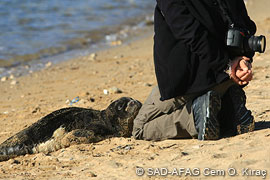 |
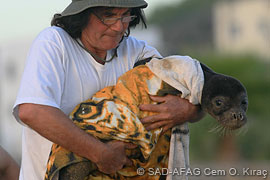 |
|
|
Pup found on the open beach in Aydıncık, Mersin. |
Pup transfer to breeding cave area in the cliff cove site. |
The SAD-AFAG team decided its priority should be to find the breeding cave and re-unite the pup with its mother, rather than taking the animal into care. At the same time, the rescue and rehabilitation centre at Foça and SAD’s new rehabilitation centre in Gökova were alerted to prepare and be ready for a possible rehabilitation should the need arise.
By 15:00 it was 31 hours in total since the pup had been found on the beach. The SAD-AFAG team and fishermen discussed the geography of the area, including the locations of sea caves, and made a dive survey along the eastern coast of Aydıncık. With the support of the Coast Guard boat and a zodiac they reached the area from Taşucu. A very suitable cove was found with several crevices, reefs, cliffs and a breeding cave, in which apparent traces of an adult and a pup seal were found. At 16:50, approximately 33 hours after it was first found, the pup was transported to the site, around 1.5nm from Aydıncık, with the help of the Coast Guard zodiac.
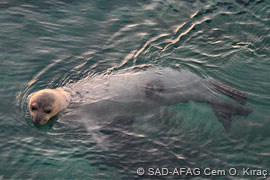 |
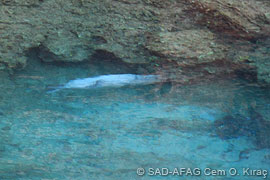 |
|
|
Mother seal around the breeding cave near Aydıncık. |
Mother seal searching underwater around the breeding cave near Aydıncık. |
The pup remained in the cove, swam and dived smoothly, did not follow the zodiac and entered one of the crevices. The following night, the pup was not observed on Aydıncık’s open beach, but observed around the release site by a local line fisherman. In the early morning of the third day, at 05:30 hours, the SAD-AFAG team arrived at the cove, taking favourite lookout points on the cliff. At 06:20 an adult female seal appeared 300 m away from the cove and approached the cave and crevices underwater, swimming calmly but cautiously. She entered the crevice that the pup had entered the previous day, following its release. She investigated other crevices as well and faint cries were heard several times. It was concluded that the pup and mother had reunited. The SAD-AFAG team left the cove area by land and surveyed Aydıncık beach and other nearby coasts. By the end of the third day on 07.11.2010 the pup was not observed again along Aydıncık beach and vicinity. Following the SAD-AFAG team’s return to Ankara, the site was put under observation by Mehmet Sarı, an Aydıncık Aqua Products Board member and artisanal fisherman. – Cem O. Kıraç and N. Ozan Veryeri, SAD-AFAG.
As a result of intensive field studies, stakeholder meetings and lobbying activities, six new “no fishing zones” have been agreed and the Ministry of Agriculture and Rural Affairs’ (MARA) decision published in the Turkish Official Gazette on July 2010. SAD-AFAG, SAD-EKOG (Ecological Research Group), Assist. Prof. Vahdet Unal of Ege University, Assist. Prof. Mustafa Erdem of Mugla University, MARA, EPASA and the three Fisheries Cooperatives (Akyaka, Akçapinar and Akbük) within Gökova Bay have been working on this issue since January 2009 within the Gökova Integrated Coastal & Marine Management Planning Project, funded by BBI Matra and executed jointly by SAD-AFAG and the Rubicon Foundation. Later on in July 2009, SAD-EKOG commenced another project on the monitoring of the marine environment in Gökova Bay including creation of no fishing zones in the area funded by UNDP-GEF/SGP. Both projects reached a successful conclusion with the establishment of six new no take zones in Turkey. The six zones (from north clockwise) are Akbük Bay, Gökova inner Bay, Çamlı Cove, Boncuk Cove & Karaca zone, Okluk Bay and Bördübet Bay (see map).
 |
|
The No-Fishing Zones (NFZs) entered into force with an announcement in the Official Gazette dated July 10, 2010 following SAD's official application to MARA in May 2010. According to the decision, the NFZs cover 23 km2 in total, approximately 7% of 307 km2 total marine area of Gökova SEPA. It is important to emphasize that this decision has been developed and implemented with the cooperation and consensus of the three fisheries cooperatives in the region. MARA, as the government body responsible for fisheries, the Environmental Protection Agency for Special Areas (EPASA), the Undersecretariat for Maritime Affairs (UMA) and the Turkish Coast Guard Command and the GEF-funded EPASA/UNDP project entitled “PIMS 3697 Strengthening the Marine and Coastal Protected Area System of Turkey” supported these efforts and SAD’s proposals officially during the process.
As a result of controlled fishing activities in Gökova Bay, it is expected that the marine ecosystem will be enhanced via increase of fish stocks and overall recovery of the marine ecosystem. Mediterranean monk seals and other predators are also expected to benefit. In these NFZs located within Gökova SEPA, the majority of which serve as fish spawning and nursery grounds, even the coastal artisanal fishermen (with set nets and long lines) are prohibited to enter. The newly established NFZs will continue to be monitored by the PIMS 3697 project, whose first year baseline studies already commenced at the beginning of October 2010; completion is due by the end of 2013.
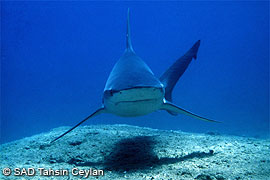 |
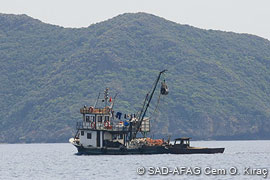 |
|
|
Endangered sandbar shark (Carcharinus plumbeus) in Boncuk Cove, Gökova Bay. |
A purse-seiner near Tuzla, Gökova Bay. |
However, the biggest challenge is controlling and preventing illegal fishing in the NFZs. Seiners and speargun divers equipped with scuba and u/w lights operating illegally in the area, should be strictly monitored by law enforcement officers or rangers. It is well known that the most significant cause of diminishing stocks of white grouper (Ephinephelus aeneus), goldblotch grouper (E. costae), dusky grouper (E. guaza), sea bream (Pagrus pagrus) and dentex (Dentex dentex) as well as octopus (Octopus vulgaris) – the species with the highest economic revenue for fishermen in Gökova Bay – is illegal speargun fishing, a highly organized and well-equipped activity in the region.
Restaurants and dealers that market such illegally caught fish also greatly contribute to the continuation of the practice in the area. SAD has been dealing with many illegal incidents and infringement cases and has worked closely with Turkish Coast Guard and Gendarmerie, and also MARA. In Gökova, around ten illegal speargun fishers have been caught while several other illegal purse-seiners and trawlers have been warned away by the Turkish Coast Guard, some of them via the timely reports of artisanal fishermen and SAD staff.
Meanwhile, in a report offering proposals to combat illegal fishing in Gökova, SAD has advised MARA that the most effective controls can be made on land, in ports and restaurants, which would serve to eliminate marketing of illegal catches. – Cem O. Kıraç, SAD-AFAG.
The 2010 “Conservation and Monitoring of the Mediterranean Monk Seal in the Foça SEPA” was completed by SAD-AFAG on 4 November. The monitoring project is a routine study that has been funded by the Environmental Protection Agency for Special Areas (EPASA) since 2008.
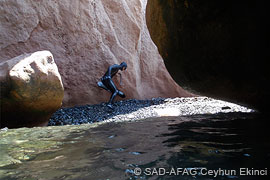 |
|
|
AFAG’s Erkin Tonguç during a cave check in Hayırsız Island in Foça SEPA. |
The population and sighting frequency of monk seals has decreased in the last decade compared to the 1994-1998 period when the number of seal sightings and number of seal traces inside caves were considerably more frequent, and when even breeding occurred on two occasions. In 2008, the number of seal sightings recorded was 31 and the number of seal traces in the caves 2, while in 2009 the number of seal sightings was 51 and seal traces in the caves zero. In 2010, the number of sightings is 117 (including SAD-AFAG direct observations) and the number of seal traces inside caves 3 (one on Hayırsız Island and the others at the Siren Rocks of Orak Island). However, SAD-AFAG assesses that the increase in sightings and traces in 2010 is not significant compared to the years 2008 and 2009 and still no breeding occurs. Also, a significant number of sightings were made in Foça Harbour in 2010, rather than in the wild habitats of the Foça SEPA. The monk seal’s decline and lack of breeding in the Foça SEPA area is believed to be attributable to a number of factors, including an increase in waterborne tourism, disturbance of monk seal habitats including breeding zones by tour boats, private leisure craft and fishing boats, overfishing and illegal fishing activities, and finally a lack of patrolling and marine surveillance. Although a fast patrol boat is available in the Foça SEPA purchased by EPASA and used by the Foça Municipality since 2008, it has not been active enough to stop or deter illegal fishing. SAD-AFAG had clearly emphasised these threats and management failings in its 2008 and 2009 monitoring reports. The management plan and preventive measures have also been presented in the following publication:
Kıraç, C.O. and H. Güçlüsoy. 2008. Foça and Mediterranean Monk Seal; Conservation and Monitoring of the Mediterranean Monk Seal (Monachus monachus) in Foça Special Environment Protection Area. EPASA Publications. December 2008. Ankara. 1-48. [PDF ![]() 2.1MB]
2.1MB]
Luckily, it is believed that all the existing problems in Foça SEPA are not irreversible, and that monk seals can recover or that even breeding may resume in the future, as long as the Foça SEPA Management Plan is implemented and enforced by the responsible authorities, with active participation and involvement of the relevant stakeholders. – SAD-AFAG.
Research for the “Gökova Integrated Coastal & Marine Management Planning” project, funded by BBI Matra, was finalized by SAD-AFAG and the Netherlands based Rubicon Foundation as of 31 October 2010. Project Manager Ozan Veryeri organized the project’s field studies, which were composed of ecological and socio-economic components, a threats assessment, and surveys among local stakeholders, including fishermen, the tourism sector, NGOs and local people. Mediterranean monk seals, marine and coastal birds, Posidonia sea grass, fish (including the sandbar shark) and macrobenthic fauna were studied by different teams. The pressure and threats on the marine and coastal ecosystem have been determined. With all the data collected in the field digitized and converted into GIS, the Gökova SEPA ICMM plan is now being drafted. Fisheries management, control of illegal fishing, enlargement of the Gökova SEPA border to incorporate monk seal breeding habitat in the northern sector, the Kadınazmağı river management plan and excursion boat quotas, protection of key coastal areas against development, endangered species monitoring and regulating anchorage of the boats to protect Posidonia sea grass beds are among the major issues that will be handled in the ICMM planning for Gökova SEPA. SAD-AFAG has managed to involve all the relevant stakeholders in the planning process, including local fishing cooperatives. – N. Ozan Veryeri and Cem O. Kıraç, SAD-AFAG.
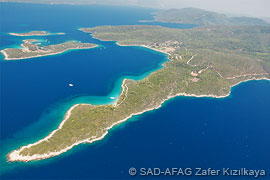 |
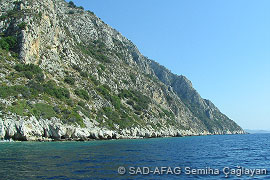 |
|
|
Aerial view of Sedir Island and vicinity in Gökova SEPA. |
Foçinler (Foça inleri= Seal caves) zone along the northern coasts of Gökova SEPA. |
A draft Act on Protection of Nature and Biological Diversity, prepared by the Ministry of Environment and Forest (MoEF) was submitted to the Turkish Grand National Assembly on 25 October 2010 to be debated and developed in the relevant commissions before final approval. The key issue in this act concerns the new decision making process on re-determination of natural SIT areas or nature protection areas having National Park or SEPA status. The act calls for the re-determination to be made by a special commission within the Ministry of Environment instead of the existing independent Protection Councils. The move has sparked considerable opposition by conservationists and their supporters, including nature protection NGOs such as TEMA (Turkish Erosion & Forestation Foundation), Nature Society (Doğa Derneği), SAD (Underwater Research Society), WWF Turkey and the Bird Research Society (KAD) as well as professional bodies such as the Chamber of Architects, Chamber of Landscape Architects, Chamber of Environment Engineers, Chamber of Metallurgical Engineers etc. and several regional Nature Protection groupings from the Black Sea, Aegean, Marmara and Mediterranean regions – altogether around 60 organizations.
Although by name the act implies conservation of nature and biological diversity, at least one critical article has caused serious disquiet in conservationist circles – the re-design of the council that will oversee the process of SIT area determination and re-evaluation. Currently this process is run by independent regional protection councils while the draft act proposes that it now be run by a new council composed of 20 representatives within the MoEF, 14 of whose members are appointed state officials and bureaucrats. Another 2 members would come from NGOs, and 4 reserved for academicians, but these too would be appointed by MoEF!
The general impression of the conservation community is that, if enacted, the measures would allow future decisions of SIT areas in the country to be influenced by political or economic pressures. In this case, the Mediterranean monk seal and its largely unspoilt habitats within the designated Important Monk Seal Sites in the country – the majority of which are 1st degree natural SIT areas – will be at risk from revision of status or downgrading. Currently, 1st degree natural SIT area designation strictly prohibits any construction or coastal development, while in 2nd or 3rd degree areas, coastal development is partially allowed; in areas without SIT status, there is no restriction on coastal development. At this stage, opposition by the conservationists to the draft act may have vital importance in determining the fate of key biodiversity areas of Turkey. The views and proposals of the relevant NGOs and scientists were not reflected in the final draft before the act was submitted to the Grand National Assembly. – Cem O. Kıraç and N. Ozan Veryeri, SAD-AFAG.
EndQuoteMalta's other seaborne migrants Rising sea levels could eliminate already scarce haul-out sites of the Mediterranean monk seal (Monachus monachus) (bumerin in Maltese), especially by the flooding of caves that provide refuge for some groups. The species may be particularly vulnerable as it is reliant on a small number of caves or narrow beaches for breeding, and these could easily be destroyed or rendered unusable by rising sea levels and increased storm frequency.
|

The views expressed by outside contributors do not necessarily reflect those of The Monachus Guardian.
|